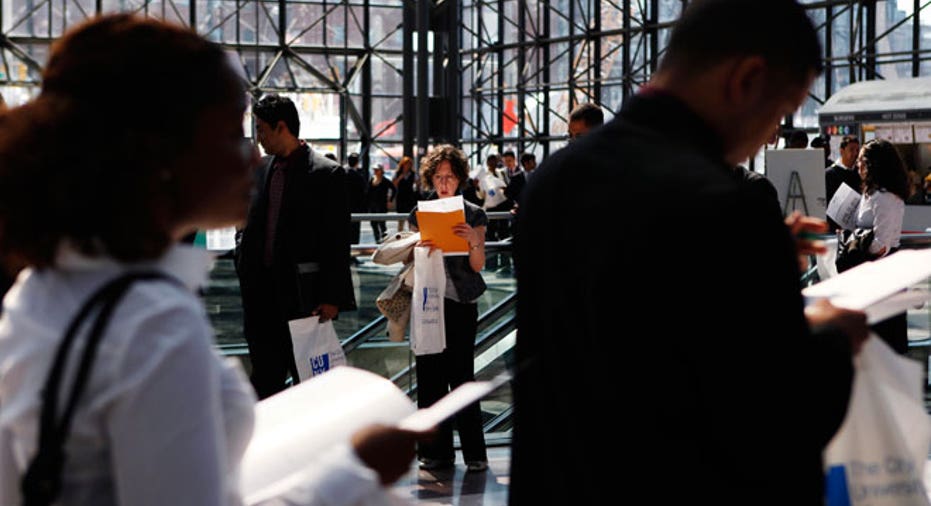May Jobs Report Suprises to the Upside

The U.S. added 280,000 jobs in May, a solid number and well above expectations, but still not enough to offer much clarity to Federal Reserve policy makers mulling the timing of an interest rate hike.
The headline unemployment rate was 5.5%, according to figures released by the U.S. Labor Department. The number ticked higher from a month ago because 400,000 more people entered the workforce.
Analysts had predicted a gain of 225,000 jobs and that the unemployment rate would hold steady at 5.4%. The U.S. has added an average of 251,000 new jobs each month, the Labor Department reported.
There was also good news on the wages front as hourly earnings rose 0.3% in May from a month earlier and, more importantly, 2.3% from a year ago.
Unemployment Rate (Seasonally Adjusted) - 10 Year | FindTheData!function(d,s,id){var js,fjs=d.getElementsByTagName(s)[0],p=/^https:/.test(d.location)?'https':'http';if(!d.getElementById(id)){js=d.createElement(s);js.id=id;js.src=p+"://cdn1.findthebest.com/rx/widgets.js";fjs.parentNode.insertBefore(js,fjs);}}(document,"script","ftb-widgetjs");
Job gains occurred in professional and business services, leisure and hospitality, and health care. Employment in mining continued to decline, according to the report, reflecting problems across-the-board in the energy sector.
“An impressive, consensus-smashing, rate of U.S. hiring puts a September rate hike firmly on the table. Job creation is surging as the economy shows signs of rebounding strongly from the weak spell seen at the start of the year, pulling wages higher and allaying worries that the upturn lacks sustainable,” said Chris Williamson, chief economist at research firm Markit.
The Fed will be pouring over these numbers trying to determining whether the U.S. economy is bouncing back in the second quarter from a disappointing first quarter during which economic growth contracted.
Economic data, including labor market figures, has been decidedly hit and miss throughout the first five months of 2015. Most labor reports have been healthy if not exactly robust, while housing and manufacturing data have frequently disappointed.
Taken together all of that mixed data resulted in a U.S. economy that actually shrunk during the first quarter. Last week the government’s second gross domestic product (GDP) estimate for the first quarter was revised downward from an earlier estimate to show that the economy contracted by 0.7% from January through March.
A larger trade deficit and a smaller accumulation of inventories by businesses was blamed for the 1Q contraction. Consumers also spent less than previously believed despite lower gas prices that put more money in consumers’ pockets. Consumer spending accounts for about 70% of the U.S. economy.
The disappointing 1Q GDP report almost certainly eliminated a rate hike at the Fed’s June meeting scheduled for June 16 and 17, and many analysts believe liftoff could be delayed past September and toward the end of the year.
Much of that will depend on the performance of the economy during the second quarter.
Median Weekly Earnings for Full Time Employees | FindTheData!function(d,s,id){var js,fjs=d.getElementsByTagName(s)[0],p=/^https:/.test(d.location)?'https':'http';if(!d.getElementById(id)){js=d.createElement(s);js.id=id;js.src=p+"://cdn1.findthebest.com/rx/widgets.js";fjs.parentNode.insertBefore(js,fjs);}}(document,"script","ftb-widgetjs");
Also under the microscope is wages, which have haven’t risen as much as the Fed (and American workers) would like, despite average monthly gains of well over 200,000 jobs for more than a year and the significant drop in the unemployment rate in the past 12 months.
The 2.3% year-over-year increase in May is a good sign but still below the 3% annual wage growth the Fed says is needed if inflation is to start moving higher.
Still, Fed officials have expressed optimism that as the job market continues to tighten that labor market slack will disappear and employers will be forced to raise wages. When they do workers will have more disposable income and (theoretically at least) buy more stuff, which will lift demand for goods and raise prices.
When prices rise at a healthy rate – the Fed prefers a 2% annual inflation rate – it suggests the economy is growing at a healthy rate.